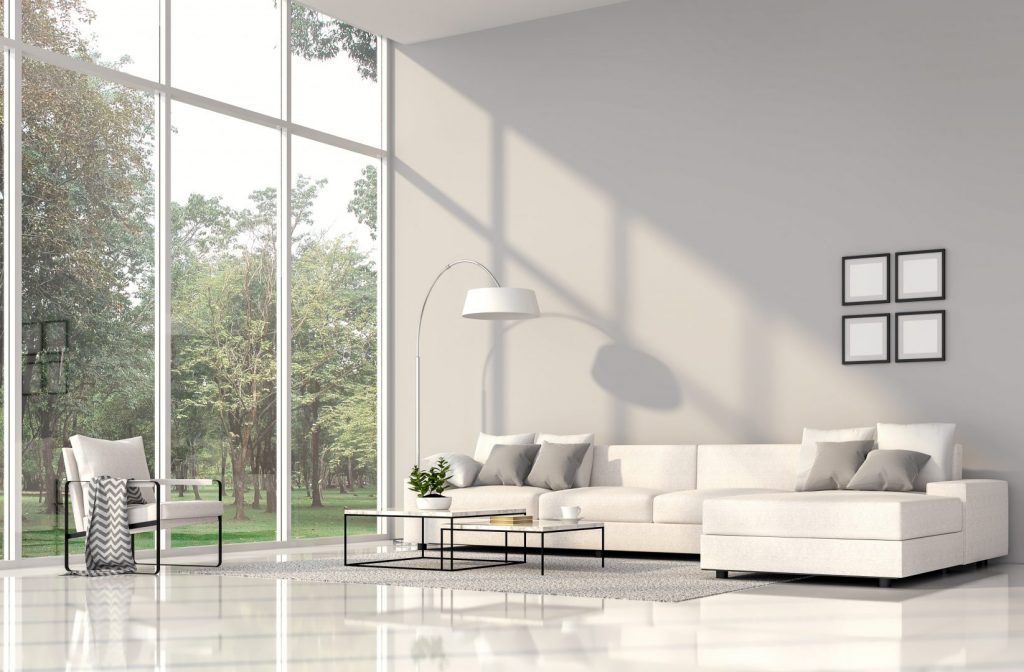
A contemporary living room that offers a hard surface flooring product, high ceilings, and full-length windows creates a comfortable and accessible living environment for its occupants
Aging in place solutions – those we create to allow people to continue living in their present homes effectively and successfully over the long-term – have many components to them. None are more important for safety, comfort, convenience, and accessibility – the big four of solutions – than lighting.
Flooring also is extremely important. Hence, we have the two interior parameters of our living space -the top or lighting (especially area and space lighting rather than lamps and other types or styles of lighting we might add in a room) and the bottom or the flooring surface on which we walk, move about within our homes, travel from room-to-room, and maintain our balance.
There are scores of other improvements we can make to a dwelling – grab bars, ramps, door hardware, doors, windows, cabinetry, counters, mirrors, fixtures, appliances, controls, technology, and more – but the top and bottom (ceiling and floor) emphasis set the stage for everything else. Without the ability to see well or clearly in a space and without the capacity to navigate it safely, the rest of the improvements we want and need to make pale.
So, let’s begin with lighting. Arguably, this is one of the most improved building products in recent memory. The advent of the LED style lighting is a major restart for the lighting industry and the way we design and furnish homes. It’s as if we are starting over and everything that existed before does not count. In fact, we would do well to forget all about it.
Depending on what type of bulbs and the quality of them (how much we pay for them), they have projected lifetimes of more than twenty years – some more than thirty years. We can make the case that we are installing lifetime bulbs for many of our clients because their bulbs will outlive them. This definitely is a sustainable solution that we are offering our clients. It promotes safety also because there is no risk of overreaching to replace a bulb or falling from trying to use a chair or ladder to reach a higher lighting fixture.
LED lighting gives us a much more uniform light than we have been able to achieve in the past without using many fixtures and increasing the heat, which was present with incandescent or halogen bulbs but not with the LED styles. Nearly all of the energy that went into lighting an incandescent bulb’s tungsten filament was lost as heat (roughly ninety-five percent of it), leaving little remaining to produce the required light.
The important thing to remember about interior residential lighting is that we require a lot of it – even more for aging eyes. Our eyes just don’t adjust to changes in distances or contrast like they did when we were younger. Therefore, more lighting is the solution. This helps to compensate for our declining natural ability to allow more light to enter our eyes in low light or darkened situations. It eliminates shadows and potential safety issues when objects are partially concealed from our view.
This is one time when we shouldn’t go overboard, however. We want plenty of light, but thinking that if a lot of lighting is desirable that even more – almost to the point of excess – lighting would be even better. If surfaces reflect the light in unexpected ways, we have glare. Glare is dangerous because our eyes aren’t allowed to experience what is in front of us – only what it appears to be. Often the glare or sheen is so strong that items are totally concealed or masked from our view.
Depending on what type of flooring is selected in a home and the amount of sheen it might have (which can relate to how slippery it might be also), lighting can hinder interior movement rather than enhance it. Nevertheless, we need more lighting, so the flooring needs to be resolved in favor of allowing lights to be on in the room without creating undue reflections or glare.
Window lighting is a great supplement to artificial lighting – during daylight hours – and extended size windows (even those going all the way to the floor or within a few inches of it) allow the maximum amount of free, natural light to enter our homes. There can be hot spots, glare, and some heat from the sun coming through the windows, but still, this offsets the need for so much artificial light sources during the daytime hours.
One of the most important safety features we can have in any home is adequate lighting – almost to the point of excessive. There are times when that may not be enough. The better things are illuminated in a home, the safer we all can be.
